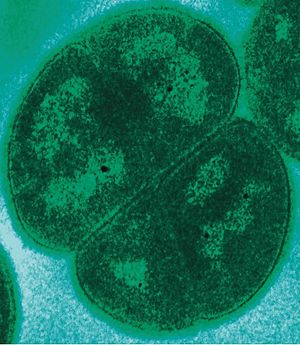Deinococcota facts for kids
Quick facts for kids Deinococcota |
|
|---|---|
 |
|
| Scientific classification |
|
| Domain: | Bacteria |
| Subkingdom: | Negibacteria |
| Phylum: | Deinococcota Weisburg et al. 2021 |
| Class: | Deinococci Garrity and Holt 2002 |
| Orders & Families | |
|
|
| Synonyms | |
|
|
Deinococcota (also known as Deinococcus-Thermus) is a group of bacteria that are super tough! They belong to a phylum (a major group of living things) and are known as extremophiles. This means they can survive in really harsh environments.
These bacteria have strong cell walls. They stain gram-positive in lab tests, but their structure is actually more like gram-negative bacteria because they have a second outer membrane.
Contents
Super-Tough Bacteria
The Deinococcota phylum includes one main group, called Deinococci. Within this group, there are two main types of bacteria, each famous for surviving different extreme conditions.
Radiation-Resistant Bacteria
One group is called Deinococcales. These bacteria are incredibly resistant to radiation. They can even survive in the vacuum of space! Some of them, like Deinococcus radiodurans, are famous for being able to "eat" nuclear waste and other toxic materials. They can also handle extreme heat and cold.
The Deinococcales group includes:
- Deinococcus
- Deinobacterium
- Truepera
Heat-Loving Bacteria
The other main group is called Thermales. These bacteria love heat! They can live in very hot places, like hot springs.
A famous member of this group is Thermus aquaticus. This bacterium was super important for developing a science technique called polymerase chain reaction (PCR). PCR helps scientists make many copies of DNA. Because PCR involves heating DNA to near boiling, using a heat-loving enzyme from Thermus aquaticus made the process much easier and more effective.
The Thermales group includes many genera, such as:
- Marinithermus
- Meiothermus
- Oceanithermus
- Thermus
- Vulcanithermus
- Rhabdothermus
Even though these two groups (radiation-resistant and heat-loving) came from a common ancestor, they developed their special survival skills independently.
How They Survive Extremes
Scientists have found special "molecular signatures" inside these bacteria. Think of these as unique internal "ID cards" or special tools that only members of the Deinococcota phylum have. These signatures help explain why these bacteria are so good at surviving extreme conditions.
For example, the Thermales bacteria have special features in their DNA-directed RNA polymerase and Type I topoisomerase that help them live in hot places. The Deinococcales bacteria have unique features in their Excinuclease ABC, DNA gyrase, and DNA repair protein RadA that help them fix their DNA after radiation damage.
The Deinococcus genus also has two well-known special proteins, PprA and DdrB. These proteins are thought to be key to their amazing ability to resist radiation.
Studying Their DNA
Scientists have studied the complete genetic information (called genomes) of several Deinococcota species. This helps them understand how these bacteria work and survive.
Some of the sequenced genomes include:
- Deinococcus radiodurans R1
- Thermus thermophilus HB27
- Thermus thermophilus HB8
- Deinococcus geothermalis DSM 11300
- Deinococcus deserti VCD115
- Meiothermus ruber DSM 1279
- Meiothermus silvanus DSM 9946
- Truepera radiovictrix DSM 17093
- Oceanithermus profundus DSM 14977
The genomes of the two Meiothermus species were sequenced as part of a big project called the Genomic Encyclopedia of Bacteria and Archaea (GEBA). This project aims to sequence the DNA of many different organisms to learn more about life on Earth.
See also
 In Spanish: Deinococcota para niños
In Spanish: Deinococcota para niños
- List of bacteria genera
- List of bacterial orders

